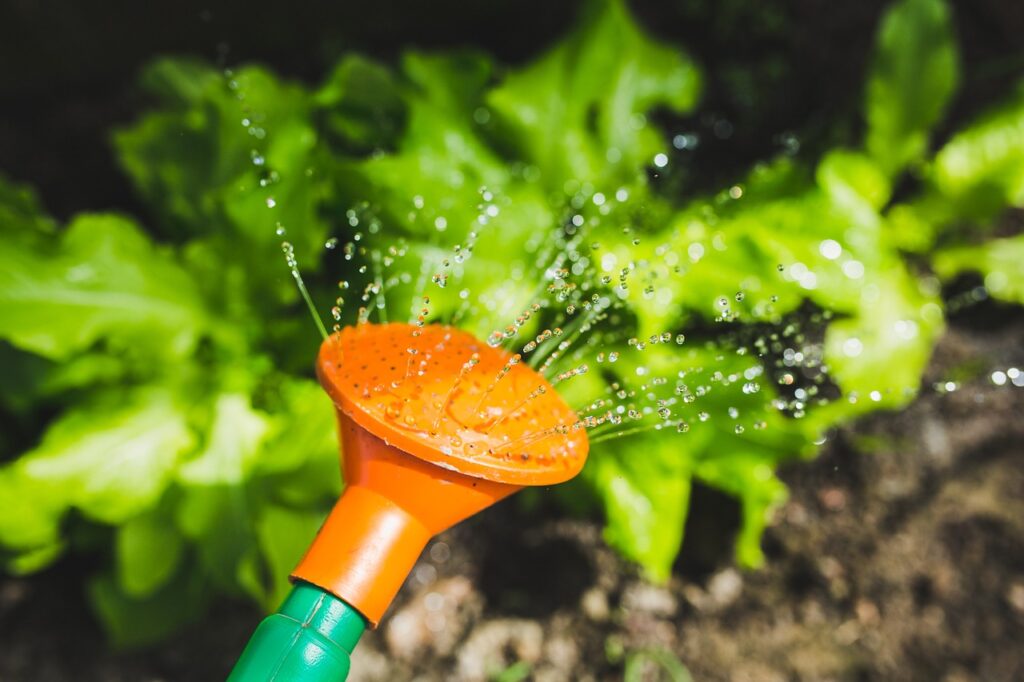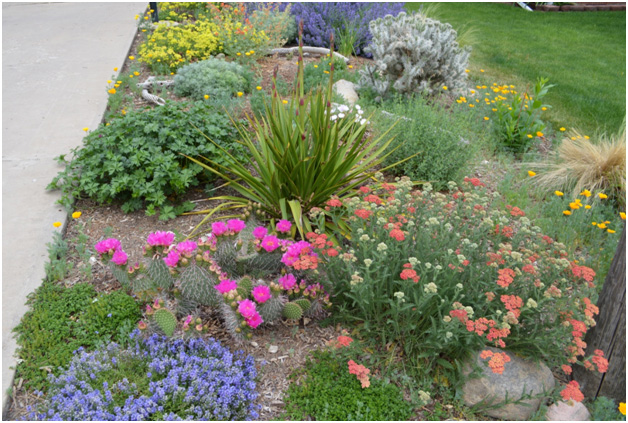by Todd Rutherford
Denver Water customers received news last year that the pH of the water delivered to them by Denver Water would be adjusted from near neutral (pH 7.5) to slightly more alkaline (pH 8.5), which began in Spring 2020.
The motivating reason for this change is for improved human health, which is highly commendable (more alkaline water is less prone to leach lead from pipes into people’s drinking water; lead is toxic to human health).
But, this announcement has many in the Landscape Industry wondering what impacts this may have on irrigating landscape plants, as well as indoor plants, and how it may affect water conveyance equipment (irrigation systems, etc).
A cursory investigation via the internet seems to indicate that the possible impacts from higher pH water on irrigation systems and the plants that receive that more alkaline water are:
- Increased mineral deposits on irrigation equipment as well as pots, planters, etc. For drip emitters this can be very problematic as the water emits at such a low and slow rate that calcium scale build-up could end up clogging the emitters.
- Reduced absorption of minerals and nutrients by the plants.
Most of the soil pH in Colorado’s Front Range are alkaline, so it is possible that this increase in pH will have little or no effect on plants that are already suited or adapted to the native soils of our area. But for plants that don’t do well in alkaline soils, will this more alkaline water be the factor that pushes those plant over the edge? Is this such a bad thing if those plants aren’t suited for our soils (and climate) to begin with?
What are some actions you can take to mitigate the problems of more alkaline water?
- Water more deeply and less often. Frequent and shallow waterings may cause more build-up of salts and minerals like calcium.
- Use alkaline adapted plants in your landscape rather than plants that need acidic soils. Generally speaking, most native plants for our region (Colorado’s eastern Front Range) are well adapted to alkaline soils.
- Check your irrigation equipment for hard water scale build-up. Clean or replace drip emitters that are clogged with scale to ensure proper water flow.
- Add Acidifying materials to the soil, like granules available from garden stores? Some experts seem skeptical of this method, saying it is very difficult to have much impact on the total alkalinity of our native soils.
- Add more organic matter such as compost? Aside from most xeric adapted plants as well as plants native to our region, many of the standard landscape plants benefit from added compost for multiple reasons. Adding compost to soil can lower the pH (more acidic) as well as aid in water retention, soil texture and provide nutrients to plants.
You may wonder if softening your water via chemical means is a good option. Several experts say this is not a good way to lower the pH of the water for plants because softened water has higher salt content, which is also problematic for plant health.
Some articles sourced on the internet mention lowering the pH of the water you irrigate your houseplants with, by adding vinegar. This may work for a small watering can used on houseplants, but for landscape plants this is simply impractical. Could an in-line fertigation system be used with an acidifier such as vinegar on landscapes? We here at ODG are uncertain about this option, but it seems like an intriguing, if also risky, option.
Time will tell how our landscapes react to the increased alkalinity of our water supply. We hope the effect is minimal, because gardening in our high altitude semi-arid climate is challenging enough as is!
This is the official blog of Outdoor Design Group, Colorado Landscape Architects. For more information about our business and our services, click here.
Related Posts:
by Matt Corrion
As water prices rise, and the climate warms, water conservation is becoming even more important. Colorado’s current population is estimated to be 5,695,564, nearly 700,000 higher than in 2010. That 13.2 percent growth is the fourth highest among all states over that time period.
All these new residents continue to put a strain on water supplies. It makes perfect sense then, to encourage Xeriscape, which, as we’ve written in the past (the-7-principles-of-xeriscape-revisited-30-years-later), is a form of landscape design that requires much less water.
We are pleased to hear of HB19-1050, a new bill in the Colorado General Assembly, that encourages the use of Xeriscape in common landscape areas.
Here is a summary of the bill:
Section 1 of the bill augments an existing law that establishes the right of unit owners in common interest communities to use water-efficient landscaping, subject to reasonable aesthetic standards, by specifically extending the same policy to limited common elements, which are owned by the community and available for use by some but not all of the unit owners.
Sections 2 and 3 extend existing water conservation requirements, currently applicable only to certain public entities that supply water at retail and their customers, to property management districts and other special districts that manage areas of parkland and open space.
This is the official blog of Outdoor
Design Group, Colorado Landscape Architects. For more information about
our business and our services, click here.
Related Posts:
by Todd Rutherford
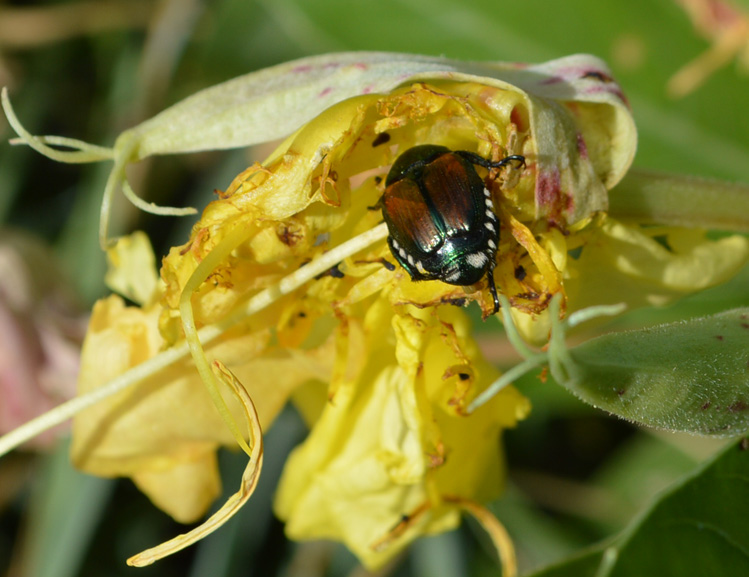
Japanese beetle eating an Oenothera flower at the Denver Botanic Gardens.
Gardeners around Colorado’s Front Range are coming face to face with a new foe in our landscapes. Japanese beetles have been a pest for years in U.S. gardens in the east, south and mid-west. It is only relatively recently that the feared invasive pest has made its presence known in Colorado.
The beetles (Popillia japonica) are believed to have entered North America via New Jersey in 1916, probably hitchhiking on ornamental nursery stock from Asia. They are voracious feeders, doing damage to trees, shrubs, perennials, annuals and turf grass. Some of the 300 favorite food plants of the adult Japanese beetles are roses, Virginia creeper, grape vines, raspberries, linden, elm and fruit trees. The sign of their destruction is skeletonized foliage and flower petals that have been devoured. The adult beetles feed during the day, preferring hot and sunny days.
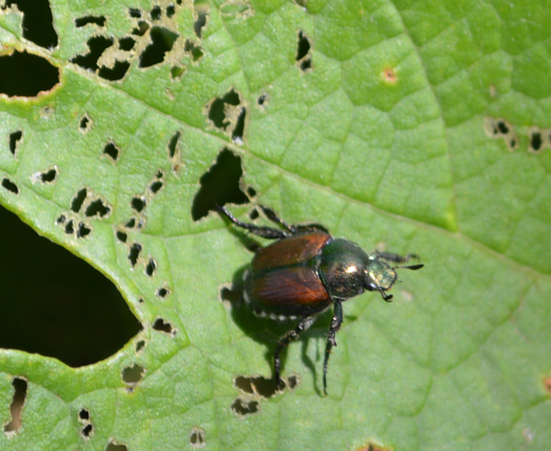
Japanese beetle on a “skeletonized” grape leaf at the Denver Botanic Gardens.
The beetle’s one-year life cycle seems tailor made for a traditional lush turf and shrub landscape. They spend winter underground as a grub, feeding on turf grass roots, creating dead patches in the lawn. In June they begin to emerge as adults ready to feed on the flowers and leaves of plants. The adults can be found feeding on plants as late as September. In addition to feeding on your landscape plants, they might be seen mating on those plants. After mating, females will move to turf grass lawns to dig into the soil to deposit their eggs. After depositing eggs, the females will resume feeding on host plants. The females will return to the lawn to lay more eggs. Up to 60 eggs can be laid by each female beetle during her 4-8 week life span.
Back in the turf grass soil, the eggs will hatch and the Japanese beetle larvae will emerge and move to the grass roots to feed. The larvae are most susceptible to drying out and dying when young if the soil dries out. That is one reason some experts advise against over watering lawns in mid to late summer. The larvae will develop rapidly, causing much damage to the turf grass roots, eventually killing some of the turf grass plants. The larvae feed on the grass roots until the temperature drops below 60 degree F. The larvae move deeper down into the soil to overwinter. Once the soil warms up in spring, the larvae move back up through the soil to resume feeding on the grass roots for about 4 to 6 weeks. After that, they begin to pupate. A couple weeks after pupation, the adults will emerge from the soil to feed on leaves and flowers, mate and start the cycle all over.
The worst damage caused by the Japanese beetles seems to be to lawns, where the larvae can cause dead patches. It appears the damage to shrubs and trees is mostly cosmetic, and will not kill those plants. However, this cosmetic damage can be significant and will upset most gardeners.
Unfortunately there is no magic bullet to control Japanese beetles in your landscape. If you discover them when they first arrive, using manual methods to collect them is a wise choice. Do not crush them, or the chemicals released upon squishing will attract more Japanese beetles to your yard. Try collecting them in a jar of soapy water. Traps are not recommended because they also attract more beetles to your yard. Pesticides may be effective at controlling the beetles. However some systemic pesticides have been linked to death of beneficial pollinating insects such as bees. For more information on the safe use of pesticides and other methods to control Japanese beetles, visit the Colorado State Extension webpage on the subject. Some experts advise the application of grub killing pesticides to lawns to kill the Japanese beetle larvae and keep your turf from being destroyed. The extension does say this about trying to control the larvae of Japanese beetles: “Some cultural practices can limit damage and applied chemical or biological controls may also be useful. However, control of Japanese beetle larvae in a yard will have very little, if any, effect on the number of Japanese beetle adults feeding on trees, shrubs and garden plants. The insect is highly mobile so that problems with adult beetles typically involve insects that have moved a considerable distance.”
As mentioned earlier, dry turf soil during the egg laying season (mostly in June & July) will keep some larvae from surviving to become adults. Some experts recommend drying out your lawn and letting it go dormant during the typical Japanese beetle egg laying time, and resuming watering after the eggs have been layed. This would seem a challenging approach to the problem as most people prefer a green, non-dormant lawn during the time of year when a lush lawn is much desired. The extension service does recommend that keeping lawns well watered after egg laying (and once the older larvae are present and most actively feeding) may help the turf survive root injuries caused by larval feeding.
It would appear that typical xeriscape plants are not usually favored by the beetles. This is yet another reason that a xeric and regionally appropriate landscape design is a good approach to follow in Denver and Colorado in general.
Let’s hope we can keep this exotic and invasive pest at bay, and not let it become an established nuisance.
This is the official blog of Outdoor Design Group, Colorado Landscape Architects. For more information about our business and our services, click here.
Related Posts:
by Todd Rutherford
The landscaping on commercial sites may be low on a business owner’s list of priorities for their property. But you should not underestimate the positive influence an attractive landscape can have on potential clients. With this in mind, here is a list of ten issues to consider for choosing the right plants to keep your property’s landscaping looking and functioning at its best.
Non-Invasive
Some very hardy plants would be great choices for commercial landscapes if not for their tendency and ability to invade and spread where they are not wanted. This may happen via seedlings or by creeping rhizomes (horizontal underground stems that can send out new roots and shoots). Luckily, here in Colorado and the Inter-Mountain West, our growing climate is challenging for many invasive plants that have ravaged milder climates in North America. However, there are some plants you should never allow to take root in Colorado due to their invasive nature. For a list of plants see: http://www.invasivespeciesinfo.gov/unitedstates/co.shtml; http://www.ext.colostate.edu/ptlk/2041.html
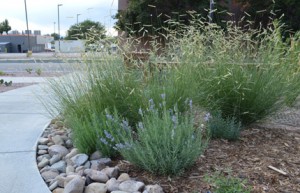
Blonde Ambition Grama Grass and English Lavender
Disease Resistant
Nobody wants to spend extra money or time dealing with or replacing diseased or dying plants. Avoid choosing plants that are easily susceptible to attack from disease or pests.
Long Lived
Along the same lines of replacing diseased plants prematurely, nobody wants to spend time and money replacing plants that live short lives. The cost of purchasing and installing landscape plants is significant, so it is wise to choose plants that will stand the test of time.
Adaptable to various exposures
The location you are planting on your property may currently be in any degree of exposure from full sun to full shade. But conditions may change in the near future. Will a new building or new trees be placed on the neighboring property? Conversely is a structure or tree slated to come down, creating a new pocket of full sun? Picking plants with higher adaptability to various exposures will ensure success for your landscape.
Adaptable to various soils
The soils in my area are typically heavy in clay with a high (alkaline) pH. This is one more challenge to add to the list of issues that face landscape plants. For best success and longevity, choose plants adapted or adaptable to the soil conditions on your property.
Adaptable to variable moisture levels
You may be familiar with desert plants and you may be familiar with rainforest plants. These two extremes of ecology illustrate the wide variability of climate that plants live in. Your landscape likely falls somewhere in between these extremes. However, even in the most average commercial landscape, we might find wide degrees of moisture and irrigation levels. Having plants that can handle these extremes will help ensure your landscapes do well.
Drought Tolerant
Although nearly all municipalities require automatic landscape irrigation, it is good if the plants you specify for a site are truly drought tolerant.
But on the flip side, some plants that are considered very low water plants may be more difficult to establish on a commercial site due to over watering. Many but not all native plants fall in this category. They are more fussy about soils and drainage. They may need to be ruled out of the “set it, and forget it” situation that many commercial clients may seek. But if you have the time or the staff to work with some very low water plants during their establishment time, they can eventually become great components of your drought tolerant landscaping. The easiest plants to use in your landscape will be adaptable to varying soil moisture levels.
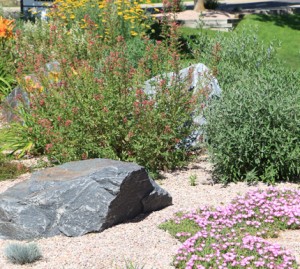
A variety of perennials and shrubs adapted to Colorado’s climate.
Not messy or difficult to maintain
Your maintenance crew has enough on their plate with regular landscape maintenance. There’s no reason to increase their burden and your costs by having messy, difficult plants on your property.
Readily available from nurseries (not rare)
If you lose some of your landscape plants due to accidents, vandalism or bad weather, you will likely want to easily replace the missing vegetation. If the plant that needs to be replaced is hard to find, you might have to resort to replacing it with one that does not match.
Attractive/Interesting/Eye-catching
Attract eyeballs and attention to your business by choosing interesting trees, shrubs and flowering plants. Just as having aesthetically pleasing buildings or signage is good for business, eye-catching vegetation and other landscape elements makes good business sense. Choose Trees and shrubs with notable flowers or good fall color.
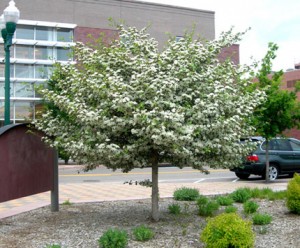
A Hawthorne tree in spring bloom.
In Summary
If you are planning a new commercial landscape or taking an assessment of your existing commercial landscape, keep these guidelines in mind. They’ll help you avoid potential problems that might repel clients and customers from your property, rather than inviting them in. An inviting landscape on your commercial property is one of the first steps to achieving business success.
This is the official blog of Outdoor Design Group, Colorado Landscape Architects. For more information about our business and our services, click here.
Related Posts:
by Guest Writer
From time to time, we here at Outdoor Design Group like to hand over the reins of this blog to a guest writer. This allows us to peer over the fence into the realm of another business, and bring our readers new views on topics related to our field of work.
This week, T.J. Wood from Plan-It Geo (a company that Outdoor Design Group has collaborated with in the past on various projects) gives us a description of an application they developed for the Colorado State Forest Service. This online tool helps Colorado communities assess their public street and park trees locally to provide a statewide picture of tree diversity and health.
Introduction:
At Plan-It Geo, we specialize in “Trees and Technology.” A tree inventory combines both of these elements seamlessly by management of this important natural resource with use of mobile devices and technology in the field. The Colorado State Forest Service contracted Plan-It Geo to develop a web-based application that communities, campuses, and HOA’s can upload their tree inventories and view important state-wide tree data summaries. To access all of our web and mobile GIS software applications, click here.

A screen shot from CO-Tree View
Colorado Tree View:
Project Profile: Colorado Tree View
Project Title: Colorado Tree View – Statewide Inventory and Ash management Application
Client: Colorado State Forest Service
Timeframe: February 2015 – Present
Description: Tree inventories provide critical information for cities, neighborhood associations, and other entities to proactively manage their urban and community forestry resource. This project provided a tool to help diversify the planning and planting of tree species. It also provided a first-time statewide view of the structure of Colorado’s urban forests. The tool is a starting point for a long-term strategy and provides substantial new technical support to communities.
Outcomes: A statewide web-based application was created for Colorado. This application has the built-in ability to “crosswalk” a wide variety of inventory data into the application. The main fields collected are species, dbh (diameter breast height), condition, and location of each tree. The application has a hierarchy of log ins based on city and user approvals with different functionality at each level. A customized dashboard was created for the state to view important number and population statistics on each community or organizational inventory.
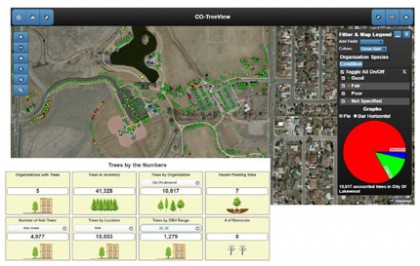
A screen shot from CO-Tree View
This is the official blog of Outdoor Design Group, Colorado Landscape Architects. For more information about our business and our services, click here.
Related Posts:
